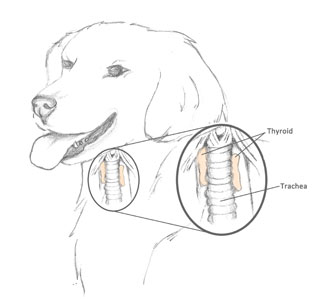Hypothyroidism in Dogs

Hypothyroidism is a common hormonal condition of dogs. The thyroid gland has two symmetrical lobes, and it is in your dog's neck just below his voice box. This important gland produces thyroid hormone, which is like a volume control for your dog's metabolism. Thyroid hormone regulates the energy level in almost every cell in the body. What happens in the thyroid affects your dog's entire system.
What Causes Canine Hypothyroidism?
Hypothyroidism occurs when the thyroid gland doesn't make enough thyroid hormone. In the majority of cases, this is the result of the destruction of thyroid cells by the dog's own immune system, a condition called lymphocytic thyroiditis. Other causes of hypothyroidism include thyroid atrophy or, less commonly, thyroid cancer. Certain drugs or other diseases can also inhibit thyroid hormone levels.
Thyroid hormone levels are regulated by the pituitary gland in the brain, so disorders affecting this gland can also result in hypothyroidism. Congenital hypothyroidism, or cretinism, in which the thyroid gland is underdeveloped at birth, occurs in dogs but is extremely rare.
Which Dogs Are Most Commonly Affected by Hypothyroidism?
Hypothyroidism generally occurs in middle-aged dogs. Medium- to large-sized breeds seem to be affected more often. Breeds in which hypothyroidism occurs commonly include:
- Golden retrievers
- Doberman pinschers
- Irish setters
- Boxers
- Miniature schnauzers
- Dachshunds
- Cocker spaniels
What Are the Signs of Hypothyroidism in Dogs?
Thyroid hormone affects the function of nearly every cell in the body, so the signs of low thyroid levels can be vague and mimic many different diseases. You may simply notice that your dog is "aging" or "slowing down." Your veterinarian looks at the overall pattern of signs rather than a single "typical" one. These signs might include:
- Weight gain
- Lethargy or mental dullness
- Intolerance to cold
- Dry or flaky skin
- Skin rashes
- Sparse, thinning hair
- Sluggish hair growth (e.g. after being clipped)
- Slow heart rate
- High cholesterol
- Anemia
How Is Hypothyroidism in Dogs Diagnosed?
Your veterinarian will start with a full physical examination and basic lab tests to rule out other major problems that may be causing your dog's signs. Next come blood tests specific for thyroid function. It sometimes takes a series or combination of tests for your vet to arrive at a diagnosis of hypothyroidism. Some tests that your veterinarian may order include:
- Total T4 level: This is the most common screening test for canine hypothyroidism. If the thyroid gland is not working properly, this level will be low. However, other diseases and certain drugs can depress blood T4 levels. Also, certain dog breeds, particularly sighthounds like greyhounds, normally have low T4 levels. Therefore, if your dog's total T4 level is low, another test is often required to confirm the diagnosis. However, if the T4 is normal, hypothyroidism is not present.
- Free T4 level: Thyroid hormone exists in two forms in the body. The majority is bound to blood proteins and is subject to daily fluctuations. A tiny fraction, the free T4, is the active form that can actually enter cells and affect their function. This blood test is more expensive but is more specific for thyroid function, particularly when concurrent illness or medications are likely to affect a dog's total T4 level.
- Endogenous TSH level: TSH levels usually become very high when the thyroid gland stops working. This is the way hypothyroidism is diagnosed in people. In dogs TSH is somewhat less sensitive for diagnosis. However, if the total T4 or free T4 levels are low and the TSH levels are high, this is diagnostic for hypothyroidism.
- TSH stimulation test: If your veterinarian suspects hypothyroidism but is unable to confirm it with conventional tests, a TSH stimulation test may be possible. A veterinarian injects your dog with synthetic human TSH and then draws blood after 8 hours to measure the total T4 level. In a normal dog, TSH should cause total T4 levels to rise. In a hypothyroid dog, there is usually no response. The TSH simulation test is a good diagnostic tool, but it is no longer used often do to the expense, the need for an 8-hour hospital stay, and the fact that TSH is often not available. The development of a reliable free T4 test has reduced the need for running many TSH stimulation tests.
- Anti-Thyroglobulin Antibodies: This test checks for the presence of antibodies against the dog's own thyroid tissue. When present, these may predict the onset of lymphocytic thyroiditis, the condition that causes most cases of hypothyroidism in dogs.
My Dog's Thyroid Results Were "Equivocal." What Happens Now?
Equivocal results are common, either because the disease is in an early phase, or because of the use of medications or the presence of concurrent illness. When this happens, your veterinarian may choose to monitor your dog every 3-6 months until the disease is more easily detected. Some veterinarians choose to treat for hypothyroidism and see if the signs improve. This is becoming a less favored practice as better and more affordable tests become available.
What Is the Treatment for Canine Hypothyroidism?
Hypothyroidism in dogs is easily treated using a synthetic thyroid hormone called levothyroxine. This is administered as a once- or twice-daily pill. Your vet starts with a standard dose based on your dog's weight. Regular blood tests and occasional dose adjustments are required to keep thyroid levels in control. Levothyroxine is safe and very effective. Hypothyroid dogs must be treated for life.
What Is the Prognosis for a Dog Diagnosed with Hypothyroidism?
The good news is that, with proper treatment and monitoring, your dog's signs should improve in days to weeks. She can live with this disorder to a ripe old age.
You May Also Like These Articles:
Hands-On Guide to Checking if Your Dog Is at a Good Weight
How To Tell If Your Dog Is Sick
Otitis Externa: Ear Infections in Dogs
Dealing With Canine Scratching and Licking
Lick Granuloma: Causes, Treatments, and Prevention of Acral Lick Granuloma in Dogs
Disclaimer: This website is not intended to replace professional consultation, diagnosis, or treatment by a licensed veterinarian. If you require any veterinary related advice, contact your veterinarian promptly. Information at DogHealth.com is exclusively of a general reference nature. Do not disregard veterinary advice or delay treatment as a result of accessing information at this site. Just Answer is an external service not affiliated with DogHealth.com.
Notice: Ask-a-Vet is an affiliated service for those who wish to speak with a veterinary professional about their pet's specific condition. Initially, a bot will ask questions to determine the general nature of your concern. Then, you will be transferred to a human. There is a charge for the service if you choose to connect to a veterinarian. Ask-a-Vet is not manned by the staff or owners of DogHealth.com, and the advice given should not delay or replace a visit to your veterinarian.



